|
Overview
The relentless rapid economic development in China is a well-documented story. Nevertheless, what has been less understood, until recently, is the explosive impact of this growth on metal and mineral demand. One such industry that is experiencing the full impact and which has yet to come to grips with the changing landscape is the steel industry. By taking a closer look at the 'China Factor' and its immediate and longer-term impact on the industry, one can better gauge the effect and impact, beneficial or otherwise, on local steel producers and downstream manufacturers.
Part 3 : The 'China Factor' - Her Role in the Changing Landscape of the Global Steel Industry
Part 1 and Part 2 of i Capital examined (A) Driver of Production and Consumption and (B) Causes of Raw Material Shortages. Under (B), it reviewed (i) Iron ore and (ii) Coking coal and coke and (iii) Steel scrap. Section (C) focused on the issue of "China - Net Importer or Exporter?" which we continue in this Part 3.
(C) China - Net Importer or Exporter?"/continued
Another key indicator as to whether China is a net importer or exporter is the level of inventories. If one argues that the country is suffering from oversupply, one has to assume that the inventory has been rising and that prices are depressed. However, that was not the case in the latter part of last year and early 2005. After peaking in May 2004, steel inventories in China have somewhat normalised, though still at relatively high levels of around 4 mln MT. Nonetheless, what is most intriguing then was that the trends in the inventories of flat sheets and long products were diverging, with flats falling (see figure 1) and longs rising, much like the trend in exports. That partly explains why sheet prices then were rising (see figure 2) and long product prices were heading south.
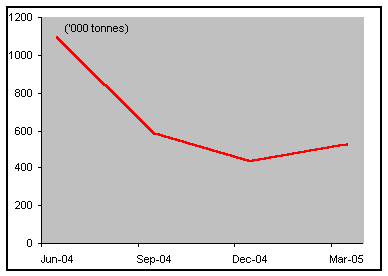
Figure 1: Inventory of HRC & CRC
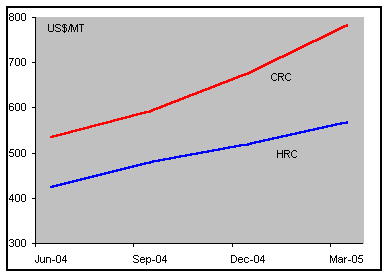
Figure 2: HRC & CRC prices
Another interesting development was the divergent trend in the inventories in Asia and the EU/North America region, which contributed to price weakness in the latter and strength in the former in the earlier part of the year. The inventories in Japan (see figure 3), one of the largest producers and consumers of steel in Asia, have been falling since the start of the year, revisiting the lows of the past 2 years. Considering that flat products make up 70% of total steel production in Japan and 78% of inventories, the shortage of high-grade steel will continue to underpin the market and provide some price support. In fact, large integrated mills in Japan are still refusing to budge in reducing contract prices on the basis that demand for their high-grade steel sheets are still exhibiting strength.
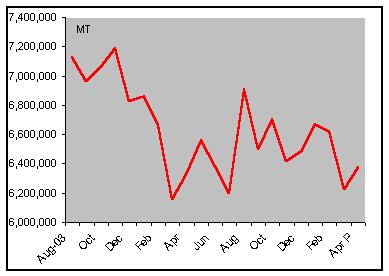
Figure 3: Japanese Steel Industry
In contrast, mills, service centers and distributors in the US and the EU, in particular, Germany, which experienced some price weakness, were busy working off their bloated inventories that had built up to levels not seen in the past 4 years, due to fears of steel shortages last year (see figure 4).
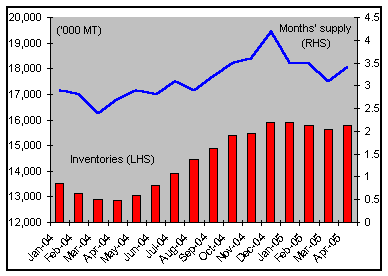
Figure 4: US Steel Inventory
While it may take more than 6 months to rectify the imbalance, signs are that there is more supply discipline for this down cycle than in previous cycles, due to the fact that production now is concentrated in the hands of fewer players (see table 1).

Table 1: % share of production of top 3 steel makers
The recent announcements by U.S. Steel and Mittal Steel to bring forward their scheduled plant shutdowns, together with production cutbacks by major European producers like Arcelor, ThyssenKrupp and Salzgitter AG, as well as production curbs from Asian millers like Posco, JFE Steel and Nippon Steel, are a major boost in efforts to shorten the down cycle and provide a platform for the subsequent recovery. Furthermore, the rebuilding efforts from the devastation of Hurricane Katrina have provided a shot in the arm to steel demand and hastened the inventory depletion process. As of Aug 2005, total steel inventories in the US have fallen by 18% from its peak in Dec 2004, with months' supply declining to 2.5 months - the lowest level since Mar 2004 (see figure 5).
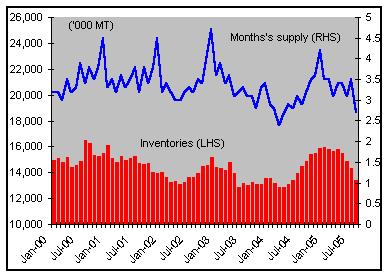
Figure 5: US Steel Inventories
|



